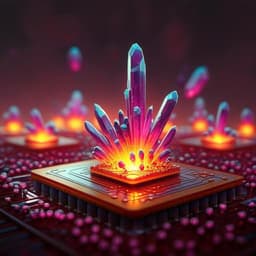
Engineering and Technology
Blue organic light-emitting diode with a turn-on voltage of 1.47 V
S. Izawa, M. Morimoto, et al.
This groundbreaking research reveals an ultra-low voltage turn-on of just 1.47 V for blue emission in OLEDs, utilizing innovative methods like charge transfer states and triplet-triplet annihilation. Conducted by Seiichiro Izawa, Masahiro Morimoto, and their colleagues, this study is set to revolutionize the field of OLED technology.
~3 min • Beginner • English
Introduction
Blue is a key primary color for display and lighting due to its highest photon energy and its role in producing white light. Despite OLED commercialization, blue OLEDs typically require high operating voltages (~4 V for 100 cd/m2) because blue photons have energies near 3 eV, making low-voltage operation difficult. Industry targets operation below ~3.7 V (Li-ion battery rating). Commercial devices still rely on conventional fluorescent emitters for stability, but these have lower EQE than phosphorescent or TADF systems. Blue phosphorescent and TADF emitters require high T1 energies (~3 eV), which accelerates chemical degradation (e.g., approaching C–N bond dissociation energy), limiting their commercial viability. Anthracene-based fluorescent emitters, in contrast, have lower T1 energies (~1.7 eV). The authors hypothesize that selectively exciting the low-energy triplet state (T1) of a conventional blue fluorescent emitter and converting it to emissive singlets via triplet–triplet annihilation (TTA) could dramatically reduce the required applied voltage. They propose an upconversion OLED (UC-OLED) architecture where a donor/acceptor (D/A) interfacial charge-transfer (CT) state sensitizes T1 of the emitter, followed by TTA to generate S1 and blue emission at much lower voltages than the emitter bandgap would suggest.
Literature Review
Background emphasizes challenges for blue OLEDs: conventional fluorescent emitters are robust but less efficient than phosphorescent/TADF; however, blue phosphorescent/TADF emitters suffer from high T1 energies (~3 eV) that can drive degradation, hindering commercialization despite recent stability advances. In conventional fluorescent OLEDs, electrical excitation generates ~25% S1 and ~75% T1 by spin statistics; to directly create S1 in the emitter generally requires an applied voltage exceeding the emitter bandgap, and energy is lost to exciton binding and S1–T1 splitting. Prior studies reported sub-bandgap turn-on and interfacial TTA upconversion using rubrene (yellow emission) and demonstrated that interfacial CT states can act as triplet precursors enabling electroluminescent upconversion at low voltages. The present work extends these concepts to blue emission using anthracene derivatives and carefully selected acceptors to form strong interfacial CT states and efficient triplet energy transfer, addressing the long-standing low-voltage blue OLED challenge.
Methodology
Device concept: UC-OLEDs that form a D/A interfacial CT state by injecting holes into the donor (emitter) layer and electrons into the acceptor (electron transport) layer; CT energy transfers to the emitter’s T1, followed by TTA to form S1 and emit blue light. Donor/acceptor selection: The emitter (donor) is the anthracene derivative 1,2-ADN, widely used in blue fluorescent OLEDs and known to satisfy TTA energy criteria (T1 ~1.7 eV, S1 ~2.9 eV). Acceptors initially screened: TmPyPB, B4PYMPM, BPyOXD (typical electron-transport materials), and NDI-HF (a strong electron acceptor used in OPVs). Devices were bilayer donor/acceptor stacks. Material energy levels (HOMO/LUMO) were taken from prior photoelectron spectroscopy and absorption data.
Screening and characterization: Fabricated 1,2-ADN/acceptor bilayer OLEDs and measured EL spectra, luminance–voltage (L–V), current density–voltage (J–V), EQE, transient EL decay, and highly sensitive IPCE to detect CT-state absorption. XRD was used to assess film crystallinity/intermolecular interaction of acceptors. To optimize acceptors, 14 NDI derivatives with varied N-substituents (aryl vs alkyl) were synthesized or procured; CT emission energies and TTA-UC intensities were measured to relate CT energy to TTA efficiency.
Optimized emission management: Introduced a small fraction of fluorescent dopant TbPe into the 1,2-ADN layer (sandwiched between undoped 1,2-ADN) to harvest S1 via Förster transfer away from the D/A interface, reducing interfacial quenching.
Device fabrication (Methods): Devices on ITO (150 nm, 10.3 Ω/sq). Layers deposited by thermal evaporation under high vacuum (~10−5 Pa): MoO3 hole-transporting layer (10 nm), donor (1,2-ADN) 40–115 nm, acceptor (50 nm), LiF (0.2 nm) electron injection, thin MoO3 (0.3 nm), and Al cathode (70 nm). For optimized devices: stack includes NDI-HF acceptor, 1,2-ADN layers (10 nm and 5 nm), and a central 1,2-ADN:TbPe (0.5 vol%) layer (25–100 nm total emission layer thickness). Active area 0.065 cm2. Devices encapsulated with UV resin and cover glass without desiccant/oxygen scavenger.
Measurements: Electrical (J–V, L–V) with Keithley 2400 or Keysight B2902A and luminance meters; highly sensitive L–V via photodiode (Hamamatsu S1223-01) with correction to match luminance meter; EL spectra with fiber spectrometer (Avaspec); EQE from absolute EL spectra and current; transient EL using square-wave drive and Si photodiode readout; IPCE with double monochromator; additional PLQE, CV, NMR, HR-ESI-MS, XRD, PYS, and phosphorescence as specified to characterize materials and energy levels.
Key Findings
- Ultralow-voltage blue emission: Optimized UC-OLED with 1,2-ADN/NDI-HF and TbPe dopant turns on (1 cd/m2) at 1.47 V and reaches 100 cd/m2 at 1.97 V. Emission peak at 462 nm (2.68 eV). Blue emission detectable down to 1.26 V by sensitive photodiode.
- Mechanism verification: For devices with typical ETLs (TmPyPB, BPyOXD, B4PYMPM), turn-on voltages were 3.5, 2.9, and 2.8 V, respectively, and EL decays were prompt (~0.2 µs) indicating direct S1 emission. For 1,2-ADN/NDI-HF, turn-on was ~1.7 V (undoped), and EL decay was slow (τ ≈ 0.85 µs), evidencing TTA-dominated upconversion from triplet excitons selectively generated via the CT state.
- CT state formation is essential: IPCE revealed strong sub-bandgap CT absorption up to ~700 nm only for 1,2-ADN/NDI-HF, indicating a pronounced D/A interfacial CT state due to strong intermolecular interactions of NDI-HF. XRD showed NDI-HF has crystallinity/strong interactions, whereas TmPyPB, B4PYMPM, BPyOXD are amorphous with weaker interactions and negligible CT absorption.
- Acceptors screening: Among 14 NDI derivatives, TTA-UC intensity increases as CT emission energy decreases. Best performance with 1,2-ADN/NDI-HF where CT energy (~1.71 eV) closely matches 1,2-ADN T1 phosphorescence (~1.77 eV), promoting efficient Dexter-type triplet energy transfer. Bulky substituents that increase steric hindrance reduce TTA-UC efficiency.
- Generality: With donor TPA-An-mPhCz (shallower HOMO), optimal acceptor shifted (NDI-Cy vs NDI-HF) to maintain CT energy close to donor T1, reinforcing the energy-alignment principle. CT absorption present for efficient pairs; absent for typical ETL B4PYMPM.
- Performance metrics: Maximum EQE of optimized TbPe-doped device is 3.25%; power efficiency 3.04 lm/W. Luminance scales quadratically at low current then linearly at high current, consistent with TTA kinetics. Theoretical maximum EQE estimated 5.5% using only triplet CT pathway or 7.3% if both singlet and triplet CT states contribute. Efficiency roll-off observed above 1000 cd/m2.
- Stability: UC-OLED (TbPe-doped) exhibits LT50 ~270 h at initial 1000 cd/m2 under simple encapsulation, versus ~3 h for a blue phosphorescent OLED using FIrPic (peak 475 nm, 2.61 eV), highlighting benefits of low-energy T1 excitation (1.77 eV in 1,2-ADN) for stability. Devices with conventional ETLs (B4PYMPM, BPyOXD) showed much shorter lifetimes, likely due to exciton quenching at interfaces.
- Practical aspects: Device can be driven by a 1.5 V battery; operation at ~1.5 V is lower than reported inorganic InGaN blue LEDs. UC-OLED works even without LiF electron-injection layer due to deep LUMO of NDI-HF, potentially improving operational lifetime by removing air-sensitive layers.
- Field/thickness independence: Threshold L–V behavior unchanged when emission-layer thickness varied between 25 and 100 nm, indicating interfacial CT processes dominate. Diode threshold for current ~1.3 V and Voc under 1 sun ~1.32 V align with ultralow EL threshold.
Discussion
The study demonstrates that selective triplet generation via a D/A interfacial CT state and subsequent TTA-mediated upconversion can decouple emission energy from the required operating voltage. By choosing donor/acceptor pairs that both form a strong CT state (enabled by strong intermolecular interactions) and align CT energy close to the emitter’s T1 energy, low-energy triplets are efficiently populated at low bias, and TTA produces high-energy singlets for blue emission. Transient EL and IPCE measurements confirm that NDI-HF uniquely enables CT formation with 1,2-ADN, driving pure TTA-UC emission and substantially lower turn-on voltage compared to typical ETLs. Optimizing the emission zone via TbPe doping suppresses interfacial quenching and improves EQE to levels comparable with conventional fluorescent blue OLEDs. Thickness-independent thresholds underscore that interfacial energetics, not bulk field, set the ultra-low-voltage operation. The sub-CT-energy onset detected at 1.26 V is consistent with non-thermal tail-state carrier recombination phenomena noted in LEDs. Importantly, because excitation proceeds via low-energy T1 (1.7–1.8 eV), material degradation associated with high-energy triplets is mitigated, yielding substantial lifetime gains over phosphorescent blue OLEDs. These findings not only address the low-voltage blue OLED challenge but also suggest routes to control triplet formation at D/A interfaces relevant to OPVs, where interfacial triplets are a major nonradiative loss pathway.
Conclusion
The authors present a blue UC-OLED achieving a record-low turn-on voltage of 1.47 V for 462 nm emission and 100 cd/m2 at 1.97 V using a conventional blue fluorescent emitter (1,2-ADN) and a strongly interacting acceptor (NDI-HF) to form an interfacial CT state that selectively populates T1, with blue emission arising from TTA. Key contributions include: identifying the necessity of strong donor–acceptor intermolecular interactions for CT formation; establishing CT–T1 energy alignment as central to efficient triplet transfer; verifying TTA-dominated emission by transient EL; and demonstrating practical device performance, stability advantages, and operation from a 1.5 V source. Future work should focus on: discovering donor/acceptor materials with optimized CT–T1 alignment and strong interfacial coupling; minimizing parasitic CT recombination and triplet-charge annihilation; refining device architectures to enhance outcoupling and reduce losses; identifying dopants that maintain ultra-low voltage while providing narrow, deep-blue emission; and translating interfacial triplet management strategies to improve OPV efficiencies.
Limitations
- EQE remains moderate (max ~3.25%) compared to state-of-the-art blue OLEDs using phosphorescent/TADF emitters (>20%), though those suffer stability issues. Calculated theoretical maxima (5.5–7.3%) indicate room for improvement by reducing loss channels (e.g., direct CT recombination, triplet-charge annihilation) and enhancing outcoupling.
- Efficiency roll-off above 1000 cd/m2 suggests annihilation processes under high excitation densities; managing triplet and charge distributions will be necessary for high-brightness applications.
- Dopant selection trade-offs: While TbPe enables ultra-low voltage and improved EQE, it yields sky-blue emission; using narrow-band deep-blue dopants like v-DABNA increased series resistance and raised turn-on voltage (~2.7 V). Identifying compatible deep-blue dopants without sacrificing low-voltage operation is unresolved.
- Simple device stacks lack specialized blocking layers; while lifetime is relatively high, further stability under commercial encapsulation and varied operating conditions remains to be established.
- Approach may depend on specific strong-interaction acceptors (e.g., NDI-HF); generalization across materials systems requires broader validation and may face morphological/processing constraints.
Related Publications
Explore these studies to deepen your understanding of the subject.







